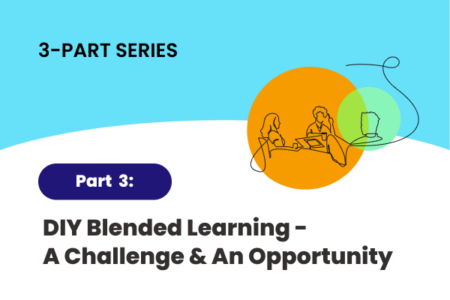In our three-part series, Blending the eLearning Experience with OpenSesame, we’ll provide an overview on blended learning, introduce global publishers who provide blended learning materials, and explore some ways you can blend the learning experience when a course doesn’t contain materials for facilitators.
By Teagan Carlson
In Part 1, I gave a brief overview of blended learning, discussed some blended learning models, and explained what makes blended learning so effective. In Part 2, we talked about some of the publishers in OpenSesame’s catalog that offer blended learning materials or additional resources that can be adapted into instructor-led training. In this article, I’ll address some of the challenges of building a blended learning program on your own. Then, I’ll provide three strategies to help you overcome those challenges, using OpenSesame courses and resources.
When elearning courses don’t include blended learning materials, you need to create them yourself. This may not be as challenging for industry-specific courses in which you have expertise or experts on hand, but what if you have a robust L&D program, one in which you’re trying to provide a flexible learning experience that meets differing learner preferences and needs? You can’t be expected to create blended materials for every learning pathway or for course subjects outside your wheelhouse. It takes time and effort to develop a blended learning experience. It also takes a lot of time to train your team or leadership to facilitate these experiences.
If the courses in your elearning program don’t contain blended learning materials, there are plenty of ways you can create a blended learning experience without exhausting your resources. I find that creating a do-it-yourself (DIY) blended learning program works best with courses that encourage active learning.
Strategy 1: Use the OpenSesame Catalog to Supplement Workshops or Seminars
If the members of your organization are attending a seminar, workshop, or presentation, you can blend their learning with elearning courses from our catalog. This works well with many topics, such as power skills, DEI, and management training. For example, let’s say you bring in a speaker to discuss identity issues in the workplace. Give your people agency over their learning with a guided SDL assignment that asks them to select a course from a list of courses you curate with the help of our Curation Specialists and your Customer Success Manager.
Strategy 2: Use Reflection Questions to Build Team Discussion
Many of the courses in our catalog include in-course reflection questions or learner guides. You can have employees take the elearning courses on their own, giving them time to process and reflect on the content independently. Then, have teams meet in person or virtually to discuss the reflection questions and learn from each other’s experiences. Alternatively, you can promote remote discussion by posting these questions to an online discussion board. This works as a blended learning experience if you or the team lead monitors and guides the discussion to provide feedback.
Strategy 3: Create Peer Teaching Opportunities
My favorite blended experiences involve peer teaching. Done well, peer teaching can be an invaluable experience for managers, leads, and team members. Like it sounds, peer teaching turns the team member into a facilitator. There are many options for peer teaching. The team member can take an elearning course or courses and discuss what they’ve learned during a Lunch and Learn, or the entire team can take the coursework and the peer teacher acts as a facilitator, creating activities and guiding the team’s discussion (the latter being the blended learning approach). Peer teaching is a powerful learning experience because it gives the peer teacher ownership of their learning, especially if there’s an SDL component to the assignment. It also fosters critical thinking, provides an opportunity to practice leadership and presentation skills, and results in improved learning outcomes because we learn more when we teach something.
For more information on blended learning, see the resources below. To get a better idea of how you can incorporate a blended learning strategy into your talent development programs using OpenSesame’s innovative tools and features, or for general inquiries, connect with one of our experts for a personalized, guided demo.
About Teagan Carlson
Teagan is an eLearning Development Specialist with OpenSesame. She has a Master’s degree in Educational Psychology and has worked in education for over fifteen years.
Teagan presented this information to the OpenSesame Customer Feedback Group in June with Senior Curation Specialist Molly Broder. The Customer Feedback Group will be hosting a follow-up meeting in September, where a panel of OpenSesame customers will share how they incorporate blending learning into their L&D programs






